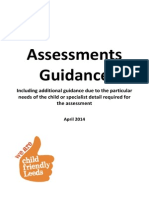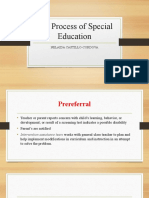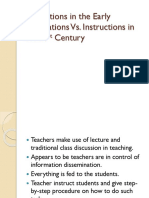0 ratings0% found this document useful (0 votes)
93 viewsSteps of The Evaluation Process
Steps of The Evaluation Process
Uploaded by
api-338545170The evaluation process for determining if a student has a disability and qualifies for special education services involves several key steps. First, concerns are presented by those who suspect a disability, such as teachers or parents. Then interventions are tried in the classroom and their effectiveness is documented. If interventions are unsuccessful, the student is referred for a formal evaluation. Next, consent is obtained from parents and evaluations are conducted by professionals like psychologists, speech therapists, and teachers. Finally, a meeting is held to review results, determine eligibility, and develop an individualized education program (IEP) if qualified for special education services.
Copyright:
© All Rights Reserved
Available Formats
Download as DOCX, PDF, TXT or read online from Scribd
Steps of The Evaluation Process
Steps of The Evaluation Process
Uploaded by
api-3385451700 ratings0% found this document useful (0 votes)
93 views2 pagesThe evaluation process for determining if a student has a disability and qualifies for special education services involves several key steps. First, concerns are presented by those who suspect a disability, such as teachers or parents. Then interventions are tried in the classroom and their effectiveness is documented. If interventions are unsuccessful, the student is referred for a formal evaluation. Next, consent is obtained from parents and evaluations are conducted by professionals like psychologists, speech therapists, and teachers. Finally, a meeting is held to review results, determine eligibility, and develop an individualized education program (IEP) if qualified for special education services.
Original Title
steps of the evaluation process
Copyright
© © All Rights Reserved
Available Formats
DOCX, PDF, TXT or read online from Scribd
Share this document
Did you find this document useful?
Is this content inappropriate?
The evaluation process for determining if a student has a disability and qualifies for special education services involves several key steps. First, concerns are presented by those who suspect a disability, such as teachers or parents. Then interventions are tried in the classroom and their effectiveness is documented. If interventions are unsuccessful, the student is referred for a formal evaluation. Next, consent is obtained from parents and evaluations are conducted by professionals like psychologists, speech therapists, and teachers. Finally, a meeting is held to review results, determine eligibility, and develop an individualized education program (IEP) if qualified for special education services.
Copyright:
© All Rights Reserved
Available Formats
Download as DOCX, PDF, TXT or read online from Scribd
Download as docx, pdf, or txt
0 ratings0% found this document useful (0 votes)
93 views2 pagesSteps of The Evaluation Process
Steps of The Evaluation Process
Uploaded by
api-338545170The evaluation process for determining if a student has a disability and qualifies for special education services involves several key steps. First, concerns are presented by those who suspect a disability, such as teachers or parents. Then interventions are tried in the classroom and their effectiveness is documented. If interventions are unsuccessful, the student is referred for a formal evaluation. Next, consent is obtained from parents and evaluations are conducted by professionals like psychologists, speech therapists, and teachers. Finally, a meeting is held to review results, determine eligibility, and develop an individualized education program (IEP) if qualified for special education services.
Copyright:
© All Rights Reserved
Available Formats
Download as DOCX, PDF, TXT or read online from Scribd
Download as docx, pdf, or txt
You are on page 1of 2
Steps of the evaluation process
1. Concerns are presented-this can be done by anyone who suspects
some may have a disability. This includes teachers, parents, guardians
etc.
2. In some schools, pre-referral teams are already in place. Interventions
are tried and documented to determine if general education
interventions can meet students needs. If so, student continues to use
those interventions and referral for evaluation is not needed. If general
education interventions are not successful, the student is often referred
by the Pre-referral team or teacher for an evaluation to determine if they
are eligible for Special Education services. The documentation of the
pre-referral interventions is valuable data as to what worked and what
did not work with the student as well all interventions tried.
3. Once the student is referred for an evaluation by teacher, parent etc. the
parent or guardian (whomever has educational rights for the child) will
sign a consent for evaluation usually presented by the School
Psychologist. Prior to signing the consent, the school must provide the
parent or guardian with Procedural Safeguards (Parental Rights).
Once the consent for evaluation is signed, the school as has a predetermined amount of days to complete the evaluation. The number of
days to complete the evaluation varies state to state.
4. The evaluation team will evaluate the student during the evaluation
period. Depending on the nature of the referral, many professionals
may be involved with this process. It may include School Psychologist,
Speech and Language Pathologist, Occupational Therapist, Physical
Therapist , Special Education teacher etc. Each does their part of the
evaluation and often consults and collaborate with one another as to
evaluation data and overall findings. Parents are often interviewed or
asked to complete rating scales etc. to get information as how the child
functions in all environments.
5. Once the evaluation has been completed, a meeting will be set up
with the parent or guardian to go over evaluation results and determine if
student has a disability and if they are eligible for Special Education
services. The parent or guardian must have at least a 10 day
(calendar) notice before the meeting. This gives them time to invite
anyone they want to go to the meeting with them if they so choose to do
so. This is their legal right.
6. A meeting is then held with all professionals who conducted an
evaluation present along with parent or guardian and it is then eligibility
for special education services is determined. It is important that
parents are involved in the determination as they are part of the
team. If it is determined the student has a disability and is eligible for
Special Education services, an IEP will then be developed to address
the needs of the student.
7.
IEPs can be written for any length of time but often they are written for
one year. They need to be reviewed at least once every year.
Anyone on the IEP team can call an IEP meeting at any time.
Members of IEP team include student, parent, Special Education
teacher, General education teacher and LEA rep (often principal).
You might also like
- I. Module Title. Special Education Process, Inclusive Education, and Teaching Strategies andDocument34 pagesI. Module Title. Special Education Process, Inclusive Education, and Teaching Strategies andit's me elsieNo ratings yet
- Table Differences Between Reggio Montessori SteinerDocument5 pagesTable Differences Between Reggio Montessori SteinerAswiniie100% (1)
- Parent BrochureDocument15 pagesParent Brochureapi-301596131No ratings yet
- Iep AssignmentDocument6 pagesIep Assignmentapi-241268840100% (1)
- 10 Steps in Making IepDocument5 pages10 Steps in Making IepCh. Asad NisarNo ratings yet
- Lesson 1 Referral Assessment and Accommodation in Special EducationDocument9 pagesLesson 1 Referral Assessment and Accommodation in Special Educationsinco lovelyn roseNo ratings yet
- The Special Education ProcessDocument3 pagesThe Special Education Processapi-569225521No ratings yet
- Module-2 - Hand-Out SNED 1Document11 pagesModule-2 - Hand-Out SNED 1Alfredo BakiaoNo ratings yet
- A Guide To The Individualized Education ProgramDocument44 pagesA Guide To The Individualized Education ProgramCho Madronero LagrosaNo ratings yet
- 10steps PDFDocument3 pages10steps PDFmeeraj1234100% (1)
- Understanding The Special Education ProcessDocument8 pagesUnderstanding The Special Education Processapi-242598376No ratings yet
- Identification and Planning For Students With Special NeedsDocument6 pagesIdentification and Planning For Students With Special NeedsbobbyalabanNo ratings yet
- Interview QuestionsDocument7 pagesInterview Questionsapi-318357965No ratings yet
- Dr. Alberto A. Jumao-As JRDocument46 pagesDr. Alberto A. Jumao-As JRClinton Mazo100% (1)
- Department of Education Department of Developmental ServicesDocument40 pagesDepartment of Education Department of Developmental ServicesvenkateshNo ratings yet
- The Top 10 Basics of Special Education 266621 7Document3 pagesThe Top 10 Basics of Special Education 266621 7api-238039846No ratings yet
- Parent BrochureDocument14 pagesParent Brochureapi-264579931No ratings yet
- What To Expect in The IEP ProcessDocument3 pagesWhat To Expect in The IEP ProcessShani4654No ratings yet
- Department of Education Department of Developmental ServicesDocument40 pagesDepartment of Education Department of Developmental ServicesJuan CabezasNo ratings yet
- Assessment and Referral Special Education by T.RicciDocument5 pagesAssessment and Referral Special Education by T.RicciGeegee Semana100% (3)
- Activity No. 5.1Document3 pagesActivity No. 5.1Cnu FaiNo ratings yet
- Special Education Analysis and RationaleDocument6 pagesSpecial Education Analysis and Rationaleapi-524477308No ratings yet
- Sned 10 Midterm ReviewerDocument2 pagesSned 10 Midterm ReviewerJay AbayonNo ratings yet
- JoymieDocument2 pagesJoymieJoy CabansagNo ratings yet
- Mid Term 342Document16 pagesMid Term 342ccNo ratings yet
- How To Read An Iep 1 1 1Document21 pagesHow To Read An Iep 1 1 1api-533709691No ratings yet
- AED 222 Assignment Channeling Students Into Special Services Week7Document5 pagesAED 222 Assignment Channeling Students Into Special Services Week7babycakes972No ratings yet
- 22 Iep 0112Document2 pages22 Iep 0112api-311125682No ratings yet
- Iep in Snie1Document34 pagesIep in Snie1NURADDIN ABDURAHMAN MUMMENo ratings yet
- File 3Document3 pagesFile 3NIXE SHANNELLE CUSAPNo ratings yet
- IEP Case StudyDocument6 pagesIEP Case Studymaria isabel diazNo ratings yet
- Kin 527 Assessment PhilosphyDocument5 pagesKin 527 Assessment Philosphyapi-711757886No ratings yet
- Special Education AssessmentDocument7 pagesSpecial Education AssessmentlorenzojondylanNo ratings yet
- Parent Brochure FinalDocument9 pagesParent Brochure Finalapi-284917509No ratings yet
- Running Head: IEP CASE STUDY 1Document14 pagesRunning Head: IEP CASE STUDY 1api-273876747No ratings yet
- The Child Assessment CycleDocument13 pagesThe Child Assessment CycleCarly LynneNo ratings yet
- UntitledDocument8 pagesUntitledBevsly VillonesNo ratings yet
- IntrotospedprogramDocument18 pagesIntrotospedprogramapi-282873721No ratings yet
- Interdisciplinary Team Discipline Plan: Responsible Thinking Process (RTP)Document8 pagesInterdisciplinary Team Discipline Plan: Responsible Thinking Process (RTP)api-307843987No ratings yet
- Initial Intake of Children With Special NeedsDocument4 pagesInitial Intake of Children With Special NeedsMary Jane Sebial ManceraNo ratings yet
- Parental Involvement in Special EducationDocument7 pagesParental Involvement in Special EducationXavy AWSMNo ratings yet
- SEN Information Report June 2018 ED2Document18 pagesSEN Information Report June 2018 ED2maharet74No ratings yet
- Assessment GuidanceDocument46 pagesAssessment GuidancetiggieNo ratings yet
- Legal Issue Special EducationDocument8 pagesLegal Issue Special Educationapi-543960455No ratings yet
- Child Study Team Presentation and HandoutDocument12 pagesChild Study Team Presentation and Handoutjennifer.johnson.k12.ga.usNo ratings yet
- Iep Case StudyDocument31 pagesIep Case Studyapi-273265436No ratings yet
- SENCO Policy Revised.27.4.2017Document6 pagesSENCO Policy Revised.27.4.2017Venice Irene PaculananNo ratings yet
- LC H Eduu 675 Signature Assignment Assessment Case StudyDocument4 pagesLC H Eduu 675 Signature Assignment Assessment Case Studyapi-510227066No ratings yet
- 1.1 Final ReadingsDocument19 pages1.1 Final ReadingsKristel FullonNo ratings yet
- Psychoeducational Assessment Page ContentDocument2 pagesPsychoeducational Assessment Page Contentapi-691702370No ratings yet
- Parent 20 Pamphlet 1Document9 pagesParent 20 Pamphlet 1api-203008463No ratings yet
- Referral Process - Flowchart ContinuedDocument1 pageReferral Process - Flowchart Continuedapi-207456114No ratings yet
- Chapter 4 ReportingDocument55 pagesChapter 4 ReportingGeo GanubNo ratings yet
- Frequently Asked Questions About Special EducationDocument4 pagesFrequently Asked Questions About Special EducationFlutterDolly Omay EsolanaNo ratings yet
- Day 2handbook Revised Feb 2012 Refrerral Process and InterventionDocument21 pagesDay 2handbook Revised Feb 2012 Refrerral Process and InterventionMa. Laarni AbergosNo ratings yet
- Report of Early Childhood Professionals' Views of AssessmentDocument15 pagesReport of Early Childhood Professionals' Views of Assessmentapi-385499627No ratings yet
- The Special Education ProcessDocument38 pagesThe Special Education ProcessNELAIDA CASTILLONo ratings yet
- Principles For Effective AssessmentDocument3 pagesPrinciples For Effective AssessmentLubna HijaziNo ratings yet
- An Introduction To Special Education: W D P IDocument15 pagesAn Introduction To Special Education: W D P Ited14344No ratings yet
- Iep Case Study PortfolioDocument14 pagesIep Case Study Portfolioapi-272099857100% (1)
- Meeting Special Needs: A practical guide to support children with Attention Deficit Hyperactivity Disorder (ADHD)From EverandMeeting Special Needs: A practical guide to support children with Attention Deficit Hyperactivity Disorder (ADHD)No ratings yet
- CVBMNDocument6 pagesCVBMNmatteoNo ratings yet
- Active Student EngagementDocument3 pagesActive Student Engagementapi-355082964No ratings yet
- Elementary EducationDocument35 pagesElementary Educationapi-3756098No ratings yet
- Interactive Phase - ISE II PDFDocument3 pagesInteractive Phase - ISE II PDFinma20No ratings yet
- English Department Disclosure DocumentDocument2 pagesEnglish Department Disclosure Documentapi-256866900No ratings yet
- 3158 w09 QP 2Document8 pages3158 w09 QP 2abe_phiriNo ratings yet
- Bahasa Inggris Kisi KisiDocument3 pagesBahasa Inggris Kisi KisilastNo ratings yet
- Instructions in The Early Generations vs. Instructions in The 21 CenturyDocument11 pagesInstructions in The Early Generations vs. Instructions in The 21 CenturyJammer AquaNo ratings yet
- Maths 0580 Paper 4 MSDocument22 pagesMaths 0580 Paper 4 MSgraceNo ratings yet
- GratitudeDocument4 pagesGratitudeRebecca EatonNo ratings yet
- Md. Arifuzzaman Tanvir: Career ObjectiveDocument3 pagesMd. Arifuzzaman Tanvir: Career ObjectiveAsif Rajian Khan AponNo ratings yet
- Second English Panel Meeting MinutesDocument7 pagesSecond English Panel Meeting MinutesNURUL NADIAH BINTI MUSTAFANo ratings yet
- fs2 Episode 2 MinsedorDocument6 pagesfs2 Episode 2 MinsedoraxielvieNo ratings yet
- 2018 COSSA Track and Field ResultsDocument41 pages2018 COSSA Track and Field ResultsPeterborough ExaminerNo ratings yet
- Keshav PassedDocument1 pageKeshav Passedprashant.rajpootNo ratings yet
- IB Extended Essay Advisor Comment and Assessment Rubric - Language BDocument12 pagesIB Extended Essay Advisor Comment and Assessment Rubric - Language BHadi AdiNo ratings yet
- Admission Form - PACE Junior Science CollegeNDocument3 pagesAdmission Form - PACE Junior Science CollegeNkdmani99No ratings yet
- 2020 Specimen Paper 1 Mark SchemeDocument2 pages2020 Specimen Paper 1 Mark SchemeNadia HayatNo ratings yet
- Estimated Cost of Attendance InformationDocument2 pagesEstimated Cost of Attendance InformationAnimesh ChoubeyNo ratings yet
- Action Plan in Mathematics Grade 4-IntegrityDocument2 pagesAction Plan in Mathematics Grade 4-IntegrityPaul John Macasa100% (1)
- Personal Statement - Rina Febrina Sarie - MonashUniversityDocument2 pagesPersonal Statement - Rina Febrina Sarie - MonashUniversityRina Febrina SariNo ratings yet
- ENGLISH-22-23 USD 253 Calendar WebDocument28 pagesENGLISH-22-23 USD 253 Calendar WebBrody DuncanNo ratings yet
- Jazz CatalogDocument40 pagesJazz CatalogJosé FerraNo ratings yet
- Untitled DocumentDocument11 pagesUntitled Documentrobymuiruri42No ratings yet
- Project Proposal - Joshua Marc EugenioDocument6 pagesProject Proposal - Joshua Marc EugenioAlvin BugayongNo ratings yet
- Action Research Proposal - Mam Milagros GuiayaDocument15 pagesAction Research Proposal - Mam Milagros GuiayaAlwin AsuncionNo ratings yet
- ApplicationDocument19 pagesApplicationGEDYION GebreNo ratings yet
- Morning Meeting Lesson PlanDocument5 pagesMorning Meeting Lesson Planapi-279806973No ratings yet
- An Evaluation of The Differences Among Lower Middle and Upper SoDocument57 pagesAn Evaluation of The Differences Among Lower Middle and Upper SoPrincess EstropeNo ratings yet

























































































